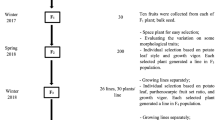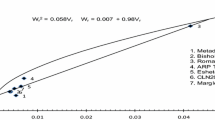Abstract
‘Nadja’ tomato (Lycopersicon esculentum Mill.) set both seedless and seeded fruits under the fluctuating temperatures prevailing during late-March and early-April in Assiut district, Egypt. Entirely seedless fruits developed under the low temperatures prevailing during Dec. Seedless fruits seemed to develop vegetatively , i.e. with no need for stimulus pollination. All seedless fruits were normally jelled and appeared similar in shape and size to the seeded fruits. Study of F1, F2, and backcross generations for the crosses ‘Cal Ace’ × ‘Nadja’ and ‘Peto-86’ × ‘Nadja’ suggested that the expression of the trait was due to single homozygous recessive gene. Yield produced by ‘Nadja’ was higher than the F1, F2, and backcross generations in both the early- summer and the late-winter plantings. Potentially useful parthenocarpic segregates were found in F2 of the two crosses for increased fruit weight of normally shaped and jelled fruits.
Similar content being viewed by others
References
Catala, M.S. & F. Nuez, 1990. Tomato fruit set under low temperatures. Acta Horticulturae 287: 171-180.
Gomez, K.A. & A.A. Gomez, 1984. Statistical procedures for agricultural research. 2nd ed. John Wiley. New York.
Hassan, A.A., M.M. Marghany & W.L. Sims, 1987. Genetics and physiology of parthenocarpy in tomato. Acta Hort. 200: 173- 183.
Ho, L.C. & J.D. Hewitt, 1986. Fruit development. In: J.G. Atherton & J. Rudich (Eds.), The Tomato Crop: A Scientific Basis for Improvement, pp. 201-239. Chapman & Hall, London.
Kean, D. & J.R. Baggett, 1986. The inheritance of parthenocarpy in Oregon T5-4 tomato. J. Amer. Soc. Hort. Sci. 111: 596-599.
Lin, S, 1982. The genetic, breeding, and physiology of parthenocarpy in Lycopersicon esculentumMill. (tomato). Diss. Abstr. Intl. Ser. B. 42: 3514.
Lin, S., W.L. George & W.E. Splittstoesser, 1984. Expression and inheritance of parthenocarpy in "severianin’ tomato. J. Hered. 75: 62-66.
Maisonneuve, B, 1978. Pollination of the tomato at low temperatures. Ph.D. Diss. Academie de Montpellier, France. (cited by Kean and Baggett, 1986).
Stevens, M.A. & C.M. Rick, 1986. Genetics and breeding. In: J.G. Atherton & J. Rudich (Eds.). The Tomato Crop: A Scientific Basis for Improvement, pp. 35-109. Chapman & Hall, London.
Vardy, E., D. Lapushner, A. Genizi & J. Hewitt, 1989a. Genetics of parthenocarpy in tomato under a low temperature regime: I. Line RP 75/59. Euphytica 41: 1-8.
Vardy, E., D. Lapushner, A. Genizi & J. Hewitt, 1989b. Genetics of parthenocarpy in tomato under a low temperature regime: II. Cultivar "severianin’. Euphytica 41: 9-15.
Author information
Authors and Affiliations
Rights and permissions
About this article
Cite this article
Mohamed, M.F. Characteristics and inheritance of natural facultative-parthenocarpic fruit-set in ‘Nadja’ tomato under low temperature conditions. Euphytica 103, 211–217 (1998). https://doi.org/10.1023/A:1018363202000
Issue Date:
DOI: https://doi.org/10.1023/A:1018363202000




